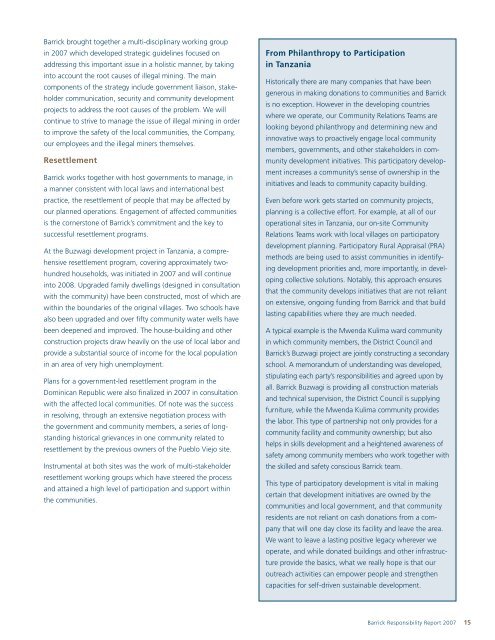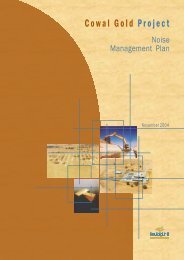2007 Responsibility Report - English (PDF) - Barrick Gold Corporation
2007 Responsibility Report - English (PDF) - Barrick Gold Corporation
2007 Responsibility Report - English (PDF) - Barrick Gold Corporation
- No tags were found...
Create successful ePaper yourself
Turn your PDF publications into a flip-book with our unique Google optimized e-Paper software.
<strong>Barrick</strong> brought together a multi-disciplinary working groupin <strong>2007</strong> which developed strategic guidelines focused onaddressing this important issue in a holistic manner, by takinginto account the root causes of illegal mining. The maincomponents of the strategy include government liaison, stakeholdercommunication, security and community developmentprojects to address the root causes of the problem. We willcontinue to strive to manage the issue of illegal mining in orderto improve the safety of the local communities, the Company,our employees and the illegal miners themselves.Resettlement<strong>Barrick</strong> works together with host governments to manage, ina manner consistent with local laws and international bestpractice, the resettlement of people that may be affected byour planned operations. Engagement of affected communitiesis the cornerstone of <strong>Barrick</strong>’s commitment and the key tosuccessful resettlement programs.At the Buzwagi development project in Tanzania, a comprehensiveresettlement program, covering approximately twohundredhouseholds, was initiated in <strong>2007</strong> and will continueinto 2008. Upgraded family dwellings (designed in consultationwith the community) have been constructed, most of which arewithin the boundaries of the original villages. Two schools havealso been upgraded and over fifty community water wells havebeen deepened and improved. The house-building and otherconstruction projects draw heavily on the use of local labor andprovide a substantial source of income for the local populationin an area of very high unemployment.Plans for a government-led resettlement program in theDominican Republic were also finalized in <strong>2007</strong> in consultationwith the affected local communities. Of note was the successin resolving, through an extensive negotiation process withthe government and community members, a series of longstandinghistorical grievances in one community related toresettlement by the previous owners of the Pueblo Viejo site.Instrumental at both sites was the work of multi-stakeholderresettlement working groups which have steered the processand attained a high level of participation and support withinthe communities.From Philanthropy to Participationin TanzaniaHistorically there are many companies that have beengenerous in making donations to communities and <strong>Barrick</strong>is no exception. However in the developing countrieswhere we operate, our Community Relations Teams arelooking beyond philanthropy and determining new andinnovative ways to proactively engage local communitymembers, governments, and other stakeholders in communitydevelopment initiatives. This participatory developmentincreases a community’s sense of ownership in theinitiatives and leads to community capacity building.Even before work gets started on community projects,planning is a collective effort. For example, at all of ouroperational sites in Tanzania, our on-site CommunityRelations Teams work with local villages on participatorydevelopment planning. Participatory Rural Appraisal (PRA)methods are being used to assist communities in identifyingdevelopment priorities and, more importantly, in developingcollective solutions. Notably, this approach ensuresthat the community develops initiatives that are not relianton extensive, ongoing funding from <strong>Barrick</strong> and that buildlasting capabilities where they are much needed.A typical example is the Mwenda Kulima ward communityin which community members, the District Council and<strong>Barrick</strong>’s Buzwagi project are jointly constructing a secondaryschool. A memorandum of understanding was developed,stipulating each party’s responsibilities and agreed upon byall. <strong>Barrick</strong> Buzwagi is providing all construction materialsand technical supervision, the District Council is supplyingfurniture, while the Mwenda Kulima community providesthe labor. This type of partnership not only provides for acommunity facility and community ownership; but alsohelps in skills development and a heightened awareness ofsafety among community members who work together withthe skilled and safety conscious <strong>Barrick</strong> team.This type of participatory development is vital in makingcertain that development initiatives are owned by thecommunities and local government, and that communityresidents are not reliant on cash donations from a companythat will one day close its facility and leave the area.We want to leave a lasting positive legacy wherever weoperate, and while donated buildings and other infrastructureprovide the basics, what we really hope is that ouroutreach activities can empower people and strengthencapacities for self-driven sustainable development.<strong>Barrick</strong> <strong>Responsibility</strong> <strong>Report</strong> <strong>2007</strong> 15
















